Density board or particleboard, which is better?
1. What is density board?
Density board, also known as fiberboard, is an artificial board made from wood fiber or other plant fibers by applying urea-formaldehyde resin or other suitable adhesives. According to different densities, density boards are separate into high-density boards, medium-density boards, and low-density boards.
The production process of density boards involves grinding wood or other plant fibers into a fine powder, then adding adhesive for mixing and pre-pressing to form the preliminary board shape. These pre-pressed slabs are then hot-pressed at high temperatures and pressures to tightly compact the wood powder. After the hot pressing is completed, it is sawed and polished to make its surface smoother.
Density board is soft, impact-resistant, has a smooth surface, is easy to reprocess, and is widely used in furniture manufacturing.
However, due to the need to add a large amount of adhesives, such as urea-formaldehyde resin, during the production process of density boards, this adhesive itself contains high levels of formaldehyde.
2. What is particle board?
Particle board, also known as chipboard, is a kind of artificial board, mainly composed of fragments of wood or other plant materials. These fragments are dried, added with adhesives and additives, and pressed under a certain temperature and pressure. These fragments account for more than 90% of the weight of the board.
The shape of the wood chips is a major factor in the quality of the chipboard, so it is to begin with vital to create qualified wood chips. The shavings left over from wood processing are reprocessed and used as the core layer of particleboard. Surface shavings are mainly produced from high-grade residues from logging or processing (timber sections, board edges, etc.). The length, thickness, and width of the shavings vary depending on the production method and whether they are used to make core or surface layers. The processing equipment for preparing shavings includes chippers, re-crushers, grinders, and fiber separators. Cutting strategies incorporate cutting, cutting, smashing, etc. In arrange to get high-quality shavings, it is fundamental to go through forms such as essential smashing, crushing, re-crushing, and screening.
The initial moisture content of processed shavings is roughly 40-60%, and the moisture content that meets the process requirements is 2-4% in the core layer and 5-9% in the surface layer. Therefore, a dryer should be used to dry wood shavings with varying initial moisture contents to achieve a uniform final moisture content. The dry shavings are at that point blended with liquid glue and additives. Typically, 8 to 12 grams of glue is applied per square meter of surface area of the wood shavings. The glue material is sprayed from the nozzle and becomes particles with a diameter of 8 to 35 microns, forming an extremely thin and uniform continuous glue layer on the surface of the wood shavings. The shavings after sizing are then laid into slabs, the thickness of which is generally 10 to 20 times the thickness of the finished product. It can be pre-pressed and hot-pressed. The pre-pressing pressure is 0.2 to 2 MPa and is carried out with a flat plate press or a roller press.
Particleboard has high hardness, good load-bearing performance, and good sound absorption and sound insulation properties. Its surface is flat and can be used for various veneers. During the production process, particleboard uses a smaller amount of glue, and its environmental protection coefficient is higher than that of density board.
However, the particle board has a granular structure inside, which can easily cause teeth to appear when cutting the board. Therefore, some processes require higher processing equipment; which is not suitable for on-site production.
3. Should I choose density board or particle board for boltless shelving?
Boltless slotted shelving is popular in the European market, Southeast Asian market, and South American market, because their end customers have limited storage space and usually do not need to place heavy items such as lawnmowers and tires on the shelving. The load requirements of shelving are relatively low, and small-sized shelving such as SG175C is usually purchased. Therefore, customers generally require 4mm MDF boards with smooth surfaces, soft texture, and low prices.
Boltless rivet shelving is popular in the United States, Canada, and Australia. End consumers in these regions generally have large garages and gardens at home. They like to place various shelves in the garage to store various garden tools. , tires auto repair tools, etc., they have higher requirements for shelf load, and they usually purchase large-sized shelves such as SP482472 and WR772472. Therefore, customers generally require 9mm particleboard with high hardness and better load-bearing performance.





